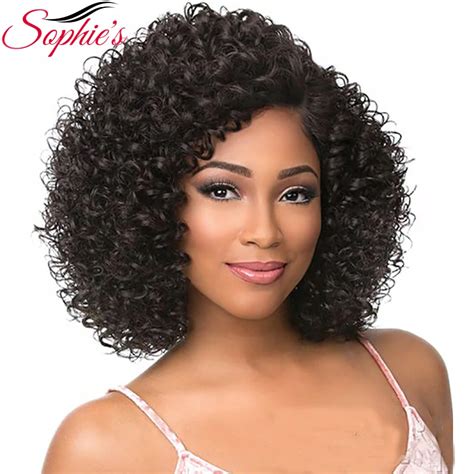Addressing the Pain Points:
African American hair, with its unique textures and patterns, often faces challenges such as:

- Styling difficulties: Coils and curls can be time-consuming and complex to style.
- Damage susceptibility: Heat styling, chemicals, and environmental factors can weaken the hair.
- Social bias: Discrimination based on hair texture persists in some societies.
The Motivational Force:
Wigs for African American hair offer a solution to these pain points, providing:
- Versatility and convenience: Change up your look with different styles and colors without damaging your natural hair.
- Protection and nourishment: Wigs shield the hair from harsh elements, allowing it to grow and flourish underneath.
- Empowerment and self-expression: Express your individuality and embrace the beauty of your hair with confidence.
Why Wigs Matter:
- According to the American Academy of Dermatology, 41% of African Americans experience hair loss.
- A 2018 study by the National Institutes of Health found that wearing wigs can improve self-esteem and body image.
- The global wig market is projected to reach $13.6 billion by 2025, driven in part by the demand for wigs specifically designed for African American hair.
Benefits of Wigs for African American Hair:
- Protective styling: Shield the hair from damage, allowing it to grow stronger and healthier.
- Wide range of styles: Choose from various textures, lengths, and colors to match your personal style and occasion.
- Instant transformation: Change your hair in minutes, without the commitment of permanent treatments or chemicals.
- Low maintenance: Wigs require less time and effort to maintain compared to natural hair.
- Confidence booster: Feel empowered and self-assured with a beautiful wig that complements your features.
Comparing Pros and Cons:
Pros:
- Versatility and convenience
- Protection and nourishment
- Empowerment and self-expression
- Improved self-esteem and body image
Cons:
- Can be expensive
- Requires regular maintenance
- May not feel as natural as natural hair
- Potential for scalp irritation
Types of Wigs for African American Hair:
- Lace wigs: Offer a natural look with a thin, transparent lace base that blends with the skin.
- Headband wigs: Easy to install and remove, featuring a comfortable headband base that fits under the hairline.
- U-part wigs: Combine lace and headband construction, providing versatility and a seamless transition from your own hair to the wig.
- Full lace wigs: Made with a full lace cap that gives the illusion of a natural scalp and allows for complete styling freedom.
Choosing the Right Wig:
- Consider your hair texture: Match the wig texture to your own hair, or opt for a different texture for a dramatic change.
- Determine your head size: Measure the circumference of your head to ensure a comfortable fit.
- Choose a reputable brand: Look for brands known for high-quality wigs designed specifically for African American hair.
- Seek expert advice: Consult with a hairstylist specialized in wigs for personalized recommendations and assistance.
Wig Maintenance Tips:
- Clean regularly: Wash your wig every 2-3 weeks with lukewarm water and specially formulated shampoo.
- Detangle gently: Use a wide-tooth comb or detangling brush to remove tangles without damaging the hair.
- Condition and moisturize: Apply conditioner to the hair after washing, and use a leave-in conditioner to prevent dryness.
- Store properly: Keep your wig on a wig stand or mannequin when not in use to maintain its shape.
- Get professional help: Regular visits to a hairstylist for wig customization, styling, and maintenance can prolong its lifespan.
Conclusion:
Wigs for African American hair are a game-changer in haircare, offering solutions to common challenges and empowering individuals to embrace their beauty. With a wide range of styles and benefits, wigs provide the ultimate versatility and protection, enhancing the confidence and well-being of those who choose to wear them.
Tables:
Table 1: Type of Wigs
| Type | Pros | Cons |
|---|---|---|
| Lace Wig | Natural look, seamless transition, versatile | Expensive, time-consuming to put on |
| Headband Wig | Easy to install, comfortable | Limited styling options, less natural look |
| U-Part Wig | Versatile, cost-effective | May not be as natural as full lace wigs |
| Full Lace Wig | Ultimate styling freedom, natural scalp appearance | Expensive, requires professional installation |
Table 2: Hair Texture Comparison
| Hair Texture | Wig Texture | Description |
|---|---|---|
| Type 3A (Loose Curls) | Loose curl patterns, defined ringlets | Soft and bouncy, easy to style |
| Type 3B (Medium Curls) | Defined curls, springy and voluminous | Requires more moisture and care |
| Type 3C (Tight Curls) | Corkscrew-shaped curls, prone to shrinkage | Dense and durable, needs hydration |
| Type 4A (Coily) | Coiled hair patterns, tight and springy | Moisture-resistant, but prone to dryness |
| Type 4B (Kinky Coils) | Kinky, zig-zag coil patterns | Delicate and fragile, requires gentle care |
| Type 4C (Tightly Coiled) | Extremely tightly coiled, almost wiry | Very dense and fine, prone to breakage |
Table 3: Wig Maintenance Schedule
| Frequency | Task |
|---|---|
| Daily | Detangle hair with a wide-tooth comb |
| Weekly | Rinse hair with lukewarm water |
| Every 2-3 Weeks | Wash hair with specially formulated shampoo and conditioner |
| Monthly | Apply deep conditioning treatment |
| Quarterly | Visit hairstylist for professional cleaning and maintenance |
Table 4: Wig Cost Comparison
| Type | Price Range |
|---|---|
| Synthetic Wig | $50-$200 |
| Human Hair Blend Wig | $150-$500 |
| Human Hair Wig | $500-$2000 |
| Custom-Made Human Hair Wig | $1000-$5000 |
